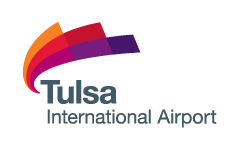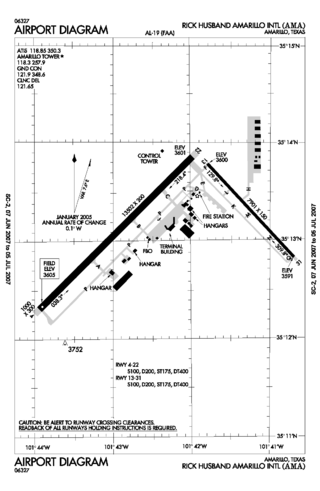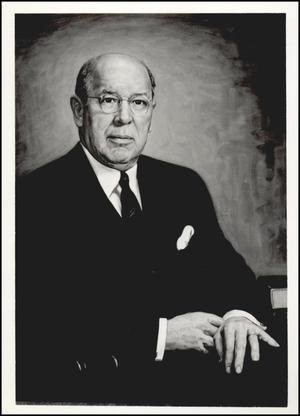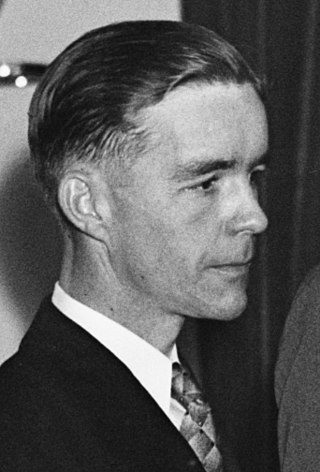
Charles Augustus Lindbergh was an American aviator, military officer, author, inventor, and activist. On May 20–21, 1927, Lindbergh made the first nonstop flight from New York City to Paris, a distance of 3,600 miles (5,800 km), flying alone for 33.5 hours. His aircraft, the Spirit of St. Louis, was designed and built by the Ryan Airline Company specifically to compete for the Orteig Prize for the first flight between the two cities. Although not the first transatlantic flight, it was the first solo transatlantic flight, the first nonstop transatlantic flight between two major city hubs, and the longest by over 1,900 miles (3,000 km). It is known as one of the most consequential flights in history and ushered in a new era of air transportation between parts of the globe.

Tulsa International Airport is a civil-military airport five miles (8 km) northeast of downtown Tulsa, in Tulsa County, Oklahoma, United States. It was named Tulsa Municipal Airport when the city acquired it in 1929; it got its present name in 1963. Despite its name, the Tulsa International Airport is not actually an international airport, and serves only domestic locations.

Rick Husband Amarillo International Airport is a public airport six miles (10 km) east of downtown Amarillo, in Potter County, Texas, United States. The airport was renamed in 2003 after NASA astronaut and Amarillo native Rick Husband, who died in the Space Shuttle Columbia disaster in February of that year.

Wiley Hardeman Post was a famed American aviator during the interwar period and the first pilot to fly solo around the world. Also known for his work in high-altitude flying, Post helped develop one of the first pressure suits and discovered the jet stream. On August 15, 1935, Post and American humorist Will Rogers were killed when Post's aircraft crashed on takeoff from a lagoon near Point Barrow in the Territory of Alaska.
This is a list of aviation-related events from 1928:

Frank Monroe Hawks was a pilot in the United States Army Air Service during World War I and was known during the 1920s and 1930s as a record breaking aviator, using a series of Texaco-sponsored aircraft, setting 214 point-to-point records in the United States and Europe. Prolific in the media and continually in the "public eye", in the 1937 The Mysterious Pilot movie serial, Hawks was billed as the "fastest airman in the world." A popular saying from the time was, "Don't send it by mail ... send it by Hawks." After retiring from a career as an air racer, he died in 1938, flying an experimental aircraft.

Hoover Field was an early airport serving the city of Washington, D.C. It was constructed as a private airfield in 1925, but opened to public commercial use on July 16, 1926. It was located in Arlington, Virginia, near the intersection of the Highway Bridge and the Mount Vernon Memorial Parkway, where The Pentagon and its northern parking lots now stand.
American Flyers Airline Corporation (AFA) was a United States "supplemental" charter airline that operated from 1949 to 1971.
Ardmore Municipal Airport is in Carter County, Oklahoma, 12 miles (19 km) northeast of the city of Ardmore, which owns it. It is near Gene Autry, Oklahoma. The National Plan of Integrated Airport Systems for 2011–2015 called it a general aviation airport.

Bader Field, also known as Atlantic City Municipal Airport, was a city-owned public-use general aviation airport located in Atlantic City, in Atlantic County, New Jersey, United States. Named after the former mayor of Atlantic City, Edward L. Bader, it was the world's first airport built specifically for fixed-wing aircraft.

The Tulsa Air and Space Museum (TASM) is an aerospace museum in Tulsa, Oklahoma, United States. It is located in the northwest corner of the Tulsa International Airport property. It has 19,000 square feet (1,800 m2) of historical exhibits, hands-on activities, and vintage aircraft. A full-dome planetarium was added in 2006. The museum also has educational facilities for school visits, summer camps, and Scout groups.

Toledo Executive Airport is seven miles southeast of Toledo, in Wood County, Ohio. It is an FAA designated reliever to Toledo Express Airport (TOL), Toledo's primary airport. Toledo Executive Airport was renamed from Metcalf Field in 2010.

Imeson Field, also known as Jacksonville Imeson Airport, was the airport serving Jacksonville, Florida, from 1927 until its closing in 1968. It was known as Jacksonville Municipal Airport prior to World War II, Jacksonville Army Airfield when the United States Army Air Forces controlled the facility during World War II, and at its closing the airport was Jacksonville – Thomas Cole Imeson Municipal Airport.

James Joseph Mattern was an American aviator. Mattern undertook a number of aviation world records, including twice attempting to break the world record for aerial circumnavigation set by Wiley Post and Harold Gatty. Both attempts failed; the second in 1933 resulted in a crash landing and subsequent rescue by Eskimos and Sigizmund Levanevsky in Siberia. In a twist of fate, Mattern would join the search for Levanevsky after he went missing in 1937. Levanevsky was never found.

Smith Field is a public airport north of downtown Fort Wayne, in Allen County, Indiana. It is owned and operated by the Fort Wayne Allen County Airport Authority. In the FAA's National Plan of Integrated Airport Systems for 2009–2013 it is a general aviation airport. The airport was listed on the National Register of Historic Places in 2002.
Spartan College of Aeronautics and Technology (Spartan) is a private for-profit aviation college in Tulsa, Oklahoma. It was originally established to provide pilot and technicians for Spartan Aircraft Company but outlived its parent company and continues to train pilots and mechanics into the 21st Century. The main campus is adjacent to Tulsa International Airport, with another campus used for flight training at Richard Lloyd Jones Jr. Airport.

William Grove Skelly was an entrepreneur who made a fortune in the oil business. Born in Erie, Pennsylvania, he moved to Kansas in 1916, then to Tulsa, Oklahoma, in 1919, where he founded Skelly Oil Company. By 1923, his company was one of the strongest independent producers of oil and gasoline in the United States. He helped organize the first International Petroleum Exposition in Tulsa in 1923 and became president of that organization, a position he held for the rest of his life. He was a founder of the Kansas-Oklahoma branch of the United States Oil and Gas Association, then known as Mid-Continent Oil and Gas Association.
Felts Field is an historic active airfield in the northwest United States, located on the south bank of the Spokane River, just east of Spokane, Washington.

American Flyers Airline Flight 280/D was a flight operated on a U.S. Military Air Command contract from Monterey Regional Airport in California to Columbus Airport in Georgia, via Ardmore Municipal Airport, Oklahoma. On April 22, 1966, while approaching Runway 8 at Ardmore, the aircraft overshot the runway and crashed into a hill, bursting into flames. Eighty-three of the 98 passengers and crew on board died as a result of the accident.

Gordon Sprigg Darnell was an American auto mechanic, airplane mechanic, Army officer, Army pilot, airmail pilot, airline pilot, volunteer fireman and one of ten recipients of the Airmail Flyers' Medal of Honor.















